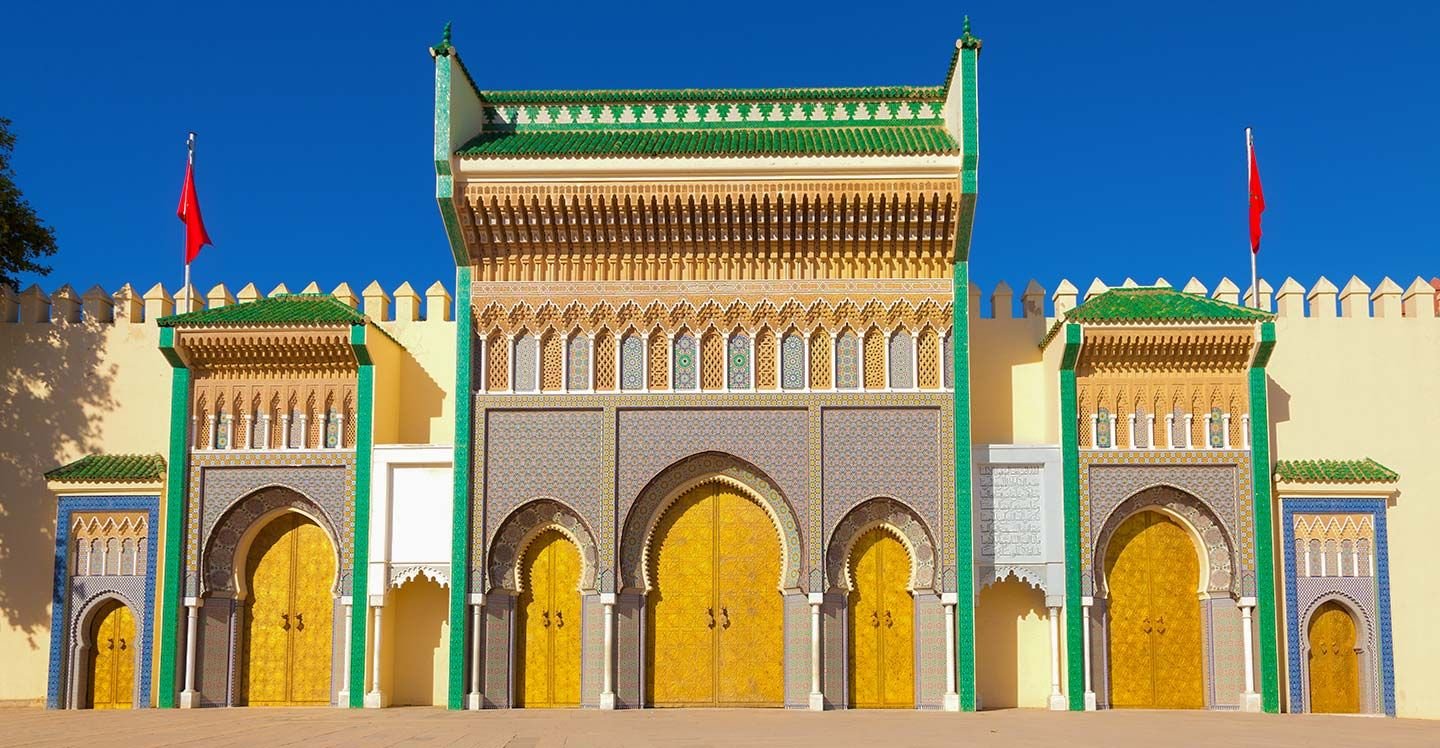Where Majesty Meets Mystery
Royal Palace Morocco: A Glimpse into the Kingdom’s Majestic Heritage
Morocco’s royal palaces stand as enduring symbols of the country’s deep-rooted history, architectural splendor, and regal traditions. Known as Dar al-Makhzen, these palatial residences are scattered across Morocco’s imperial cities, each reflecting the craftsmanship and grandeur of different dynasties. While these palaces remain off-limits to the public, their breathtaking exteriors, historic gates, and surrounding landmarks offer visitors a fascinating glimpse into the kingdom’s royal heritage.
For travelers seeking a deeper connection to Moroccan culture, visiting these iconic sites provides an opportunity to witness intricate Moroccan architecture, appreciate centuries-old craftsmanship, and explore the vibrant neighborhoods that have grown around them. This guide delves into the most famous royal palace Morocco, their history, architectural features, and the must-see attractions nearby. Whether visiting Fez, Rabat, or Marrakech, every royal palace tells a story of power, tradition, and artistic excellence.
Our team is here to assist you. Contact us on WhatsApp for more information.
1. The Royal Palace of Fez: A Jewel Behind Golden Doors
Fez, Morocco’s spiritual and cultural capital, is home to one of the most magnificent royal palace Morocco. The Royal Palace of Fez (Dar al-Makhzen) is a testament to the city’s imperial past and the grandeur of Moroccan craftsmanship. Although the palace is not open to visitors, its massive golden doors and elaborate façade make it one of the most photographed landmarks in Fez.
Architectural Highlights
- Massive Bronze Doors: The palace’s main entrance features towering golden doors, intricately engraved with geometric patterns and framed by traditional zellige tilework.
- Carved Cedarwood Panels: Above the gates, hand-carved cedarwood panels showcase the meticulous artistry of Moroccan woodworkers.
- Seven Gates: The number seven holds spiritual significance in Islamic tradition, and the palace’s seven main gates symbolize different aspects of power and governance.
Nearby Attractions
- Mellah (Jewish Quarter): Adjacent to the palace, this historic quarter offers insight into Fez’s diverse cultural heritage, with synagogues, traditional homes with wrought-iron balconies, and the Jewish cemetery.
- Jnan Sbil Gardens: Just a short walk from the palace, these lush botanical gardens provide a serene retreat from the bustling city.
- Fez el-Bali Medina: A UNESCO World Heritage site, Fez’s ancient medina is a maze of narrow streets filled with centuries-old mosques, madrassas, and artisan workshops.
Local Travel Tips
- The best time to visit the palace gates is in the late afternoon when the golden doors reflect the sunlight, creating a stunning visual effect.
- Hiring a local guide can enhance your experience, offering historical context and lesser-known facts about the palace and its surroundings.
2. The Royal Palace Morocco: Where Power Meets Prestige
As the political heart of Morocco, Rabat is home to a royal palace that remains a working residence for King Mohammed VI. Unlike other palaces, this one serves as an administrative hub, hosting official ceremonies and diplomatic events. While visitors cannot enter, the grandeur of its vast walled complex, beautifully maintained gardens, and surrounding landmarks make it a key stop in the capital city.
Architectural Highlights
- Expansive Grounds: Covering a vast area, the palace complex includes royal offices, guest residences, and lush courtyards.
- Ceremonial Guards: The presence of uniformed guards adds to the palace’s regal atmosphere, offering a glimpse of Morocco’s military traditions.
- Ornate Gates: The main entrance is adorned with carved plaster, horseshoe arches, and delicate tilework, reflecting classic Moroccan architectural styles.
Nearby Attractions
- Mausoleum of Mohammed V: A short distance from the palace, this white-marble mausoleum houses the tombs of King Mohammed V and his sons, Hassan II and Prince Abdallah. The intricate calligraphy and mosaic work inside make it a must-visit.
- Kasbah of the Udayas: Overlooking the Atlantic Ocean, this historic fortress is a UNESCO-listed site featuring blue-painted alleyways, panoramic views, and the peaceful Andalusian Gardens.
- Hassan Tower: The unfinished minaret of a 12th-century mosque, Hassan Tower stands as a symbol of Morocco’s grand architectural ambitions.
Local Travel Tips
- Visitors can witness the changing of the Royal Guard outside the palace gates, typically occurring in the late morning.
- The best way to explore Rabat’s royal and historical sites is with a guided city tour, ensuring deeper insights into their significance.
3. The Royal Palace of Marrakech: A Regal Presence in the Red City
Marrakech, known for its vibrant souks, historic medina, and luxurious riads, is also home to one of Morocco’s most historically significant royal palaces. The Royal Palace of Marrakech, dating back to the Almohad dynasty, has been a center of power for centuries. While the palace itself remains closed to visitors, its high walls and strategic location within the medina make it an essential stop for history enthusiasts.
Architectural Highlights
- Fortified Walls: The palace is surrounded by tall red-earth walls, blending seamlessly into Marrakech’s famed terracotta-colored architecture.
- Historic Legacy: Built in the 12th century, it has housed various sultans and kings, making it one of the oldest continuously used palaces in Morocco.
Nearby Attractions
- Bahia Palace: This 19th-century palace offers an accessible alternative, showcasing exquisite stucco work, cedarwood ceilings, and tranquil courtyards.
- Saadian Tombs: Dating back to the 16th century, these royal tombs are adorned with intricate marble and tile designs.
- Jemaa el-Fnaa Square: The heart of Marrakech’s medina, this lively square is filled with street performers, traditional food stalls, and snake charmers.
Local Travel Tips
- While the Royal Palace of Marrakech is not open to the public, guided medina tours often pass by its outer walls, offering historical insights.
- For a luxurious royal experience, visitors can enjoy Moroccan tea at La Mamounia, a historic hotel that has hosted royalty and celebrities.
Planning Your Visit to the Royal Palace Morocco: Essential Tips for Travelers
Best Time to Visit Morocco’s Royal Palaces
- Spring (March–May) and Fall (September–November) offer the most pleasant weather for sightseeing.
- Early mornings and late afternoons provide the best lighting conditions for photography.
Where to Stay for a Royal Experience
- Luxury Hotels: The Royal Mansour in Marrakech and La Mamounia offer world-class hospitality with Moroccan royal influences.
- Traditional Riads: Staying in a riad in Fez, Marrakech, or Rabat provides an authentic Moroccan experience with elegant courtyard architecture.
Cultural Etiquette
- Respect the Royal Spaces: Photographing palace guards or security personnel is not allowed.
- Appropriate Dress: Modest clothing is recommended, especially when visiting religious or royal sites.
- Learn a Few Local Phrases: Simple Arabic greetings like Salam alaikum (peace be upon you) are appreciated by locals.
Discovering Morocco’s Royal Legacy: A Journey Through the Royal Palace Morocco
Morocco’s royal palaces offer more than just stunning architecture—they provide a window into the country’s regal traditions, artistic mastery, and historical significance. While visitors may not be able to step inside these palatial complexes, the surrounding landmarks, rich history, and breathtaking exteriors make them an essential part of any Morocco itinerary.
For travelers eager to experience the grandeur of Morocco’s royal heritage, exploring these sites, coupled with guided tours, luxury accommodations, and local cultural experiences, will create an unforgettable journey through the kingdom’s majestic past.
Questions? Chat with us now on WhatsApp for a quick response!



